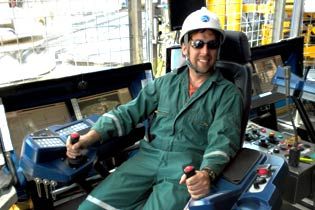
Michele Cooke Andresen and Mariel Schottenfeld illustrate how future earthquakes may occur around the San Andreas Fault through special clay modeling techniques in a video available for viewing on YouTube.
Category: Geology

Four faculty members have been elected fellows of the American Association for the Advancement of Science in recognition of their scientifically or socially distinguished efforts to advance science or its applications.
They are Raymond Bradley, Geosciences; Peter Hepler, Biology; Lynnette Leidy Sievert, Anthropology, and Vincent Rotello, Chemistry.
Bradley was recognized for “distinguished contributions to the fields of climatology and paleoclimatology, particularly in Arctic and alpine environments, and for international leadership in high-resolution paleoclimatology.” As the director of the Climate Science Research Center, Bradley has specialized in reconstructing how climates in the past differ from today, using natural archives such as lake sediments, ice cores, tree rings and other records. Focusing on Arctic and alpine environments, he has taken more than 35 expeditions to remote sites in Canada, Greenland, Scandinavia, China and the high mountains of the tropics.
Hepler was cited for his contributions as “one of the most influential plant cell biologists, who has continuously and continues to achieve breakthroughs that have guided research directions of numerous plant scientists.” Hepler, a cell biologist and physiologist, explores cell growth and division using a variety of microscopic methods. By introducing reporter molecules into living cells, he examines the position and organization of underlying structures such as the cytoskeleton and membranous organelles, and the location and activity of fluxes and gradients of ions such as calcium and protons. The correlations of these data provide insight into the underlying control of cell growth and division.
Sievert was honored for “distinguished contributions to the biocultural study of women’s health, particularly for enhancing understanding of menopause and its relation to broader aspects of women’s lives.” A biological anthropologist, Sievert specializes in reproductive ecology and older women’s health, mostly focused on population variation in age at menopause, symptom experience at midlife and the evolution of menopause and post-reproductive life. She has carried out field work in the United States, Paraguay, Slovenia and Bangladesh. Sievert and colleague Gillian Bentley are now studying how Bangladeshi immigrants in London compare to women in Bangladesh in terms of age at menopause, hormone levels and symptom experience. Findings include symptom and hormonal differences between Muslim and Hindu women.
Rotello was recognized for “distinguished contributions to supramolecular chemistry, particularly the use of nanoparticles in self-assembly and sensing.” Rotello’s research has focused on how molecules interact and in particular, how nanoparticles can be engineered to provide advanced materials, therapeutics and diagnostics. He is a pioneer in polymer-mediated “bricks and mortar” assembly of nanoparticles. His efforts in therapeutics have generated nanoparticles for drug delivery and gene therapy. Most recently, Rotello is working on diagnostics, developing sensors that can not only detect cancer, but differentiate between different cancers, including metastatic and non-metastatic varieties.
Their names were released in the AAAS News & Notes section of the journal Science on Dec. 18.
The new AAAS Fellows will each receive an official certificate and a rosette pin in a ceremony on Feb. 20 during the 2010 AAAS annual meeting in San Diego. According to AAAS, the tradition of electing fellows began in 1874.
December 18, 2009.
Getting In Deep
One must drill the depths to study how earthquakes are born

In June, UMass hydrogeologist David Boutt boarded the vessel Chikyu, and headed for the coast of Japan. Chikyu’s deck carries the world’s tallest ship-borne drill rig, a 327-foot derrick specially made to drill deeper than ever before—up to 4.34 miles below the sea floor. It’s also fully equipped with scientific laboratories allowing immediate sample analysis.
Boutt was one of more than a dozen scientists from seven nations staffing the research vessel for a six-week cruise. They studied conditions near the clash of two massive tectonic plates, the Eurasian and the Philippine, in one of the most seismically active areas on the planet. Data from the trip will “help us better understand the mechanics of the often massive earthquakes in this very active zone,” Boutt explains.
Boutt is an expert in the mechanics and flow paths of subsurface aqueous fluids, a term for warm, pressurized water that’s been so altered by sediment load, dissolved chemicals, or both that it can’t be called simple water anymore. It moves through fractured rocks and faults and is forced out of ocean floor cracks near accretionary prisms to play an integral role in the genesis of earthquakes and tsunamis, but its relationship to tectonic events is not well understood.
On July 1, Boutt blogged, “Everyone is in a good mood as we reached our target coring zone. We’re busy working on the cuttings recovered.” July 4: “Looks like we have entered into the accretionary prism which could be as old as 8 million years, and we have a 4-million-year unconformity across the transition.”
Boutt’s blog often mentioned treats such as home-cranked ice cream, playing games, and jogging around the heli-deck for fresh air and exercise, all of which help researchers and crew unwind after long work hours away from home.
Other goals of the summer project, led by the Japanese government and known as Nankai Trough Seismogenic Zone Experiment (NanTroSEIZE), included installing sensors in deep boreholes to monitor the Earth’s crust for earthquake and tsunami activity. Overall, NanTroSEIZE project organizers say, “This deep sea drilling research opens the new frontier of earth and life science for future of mankind by revealing the system of major earthquakes, global changes and origin of life.”